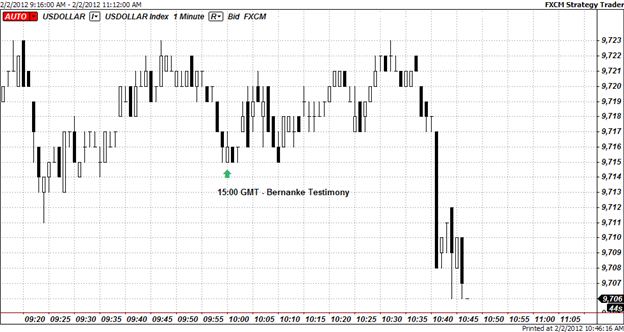THE TAKEAWAY: [Fed’s Bernanke Testifies Before House] > [Urges Caution in Overly Rapid Deficit Cutting] > [USD Weakens]
Federal Reserve Chairman Ben
Bernanke testified before the House Budget Committee on the U.S.
economic outlook today. The appearance comes just a week after the Fed’s
announcement that it is likely to keep interest rates near zero until
at least late 2014, extending its previous time frame by at least a year
and a half.
At the testimony, Bernanke
began by defended the FOMC’s decision to maintain its highly
accommodative stance of monetary policy and to maintain its program to
extend the average maturity of its securities holdings. Bernanke
reiterated a bearish tone on the U.S. economic recovery, describing the
pace of recovery as “frustratingly slow”, although the Fed is indicating
that expect a somewhat stronger growth this year than in 2011.
Moving onto fiscal policy
challenges, Bernanke warned against overly rapid deficit cutting,
appealing to lawmakers that “even as fiscal policymakers address the
urgent issues of fiscal
sustainability, they should take care not to unnecessarily impede the
current economic recovery. Fortunately, the two goals of achieving
long-term fiscal sustainability and avoiding additional fiscal headwinds
for the current recovery are fully compatible--indeed,
they are mutually reinforcing.” Even after economic conditions have
returned to normal, the Fed cautioned that the nation will still face a
sizable structural budget gap if current budget policies continue. Even
assuming that the economy is close to full employment, the Fed
anticipates that the budget deficit would be more than 4 percent of GDP
in fiscal year 2017.
US Dollar 1-minute chart: 2 February 2012

Immediately after the release of Bernanke’s testimony, the U.S. dollar pared back recent losses, with the U.S. Dollar Index (Ticker: USDOLLAR) reaching
9723 before tumbling down towards 9706 at the time of this report. The
U.S. dollar fell against major currencies including the euro, Australian
dollar and Canadian dollar.
The U.S. dollar declined
sharply as the markets viewed the FOMC’s announcement as “dovish”,
allowing a third round of quantitative easing to remain on the table for
some time this year.
In his testimony, Bernanke noted the following outlook on the U.S. economy and fiscal policy challenges:
Having a
large and increasing level of government debt relative to national
income runs the risk of serious economic consequences. Over the longer
term, the current trajectory of federal debt threatens to crowd out
private capital formation and thus reduce productivity growth. To the
extent that increasing debt is financed by borrowing from abroad, a
growing share of our future income would be devoted to interest payments
on foreign-held federal debt. High levels of debt also impair the
ability of policymakers to respond effectively to future economic shocks
and other adverse events.
Even the
prospect of unsustainable deficits has costs, including an increased
possibility of a sudden fiscal crisis. As we have seen in a number of
countries recently, interest rates can soar quickly if investors lose
confidence in the ability of a government to manage its fiscal policy.
Although historical experience and economic theory do not indicate the
exact threshold at which the perceived risks associated with the U.S.
public debt would increase markedly, we can be sure that, without
corrective action, our fiscal trajectory will move the nation ever
closer to that point.
To achieve
economic and financial stability, U.S. fiscal policy must be placed on a
sustainable path that ensures that debt relative to national income is
at least stable or, preferably, declining over time. Attaining this goal
should be a top priority.
Even as
fiscal policymakers address the urgent issue of fiscal sustainability,
they should take care not to unnecessarily impede the current economic
recovery. Fortunately, the two goals of achieving long-term fiscal
sustainability and avoiding additional fiscal headwinds for the current
recovery are fully compatible--indeed, they are mutually reinforcing. On
the one hand, a more robust recovery will lead to lower deficits and
debt in coming years. On the other hand, a plan that clearly and
credibly puts fiscal policy on a path to sustainability could help keep
longer-term interest rates low and improve household and business
confidence, thereby supporting improved economic performance today.
Fiscal
policymakers can also promote stronger economic performance in the
medium term through the careful design of tax policies and spending
programs. To the fullest extent possible, our nation's tax and spending
policies should increase incentives to work and save, encourage
investments in the skills of our workforce, stimulate private capital
formation, promote research and development, and provide necessary
public infrastructure. Although we cannot expect our economy to grow its
way out of our fiscal imbalances, a more productive economy will ease
the tradeoffs that we face and increase the likelihood that we leave a
healthy economy to our children and grandchildren.
No comments:
Post a Comment